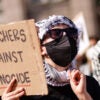President Joe Biden’s Build Back Better plan aims to build, sure enough. That is, build atop the massive amount of welfare that the federal government doles out.
Right now, there are a huge number of Americans simply not working, as most Americans know, given the huge number of “help wanted” signs in front of businesses around the country.
Federal policies are at least partly to blame for this, as welfare benefits have been made so generous that many are simply choosing not to work. This has led to a gaping hole in the U.S. workforce.
The Daily Signal depends on the support of readers like you. Donate now
No wonder so many things seem broken and dysfunctional right now.
Some of the programs included in the bill will, if passed, likely make the worker shortage even worse.
At a time when countless Americans aren’t working, the supply chain is breaking down, and inflation is getting out of control, the Biden administration is choosing to massively expand federal welfare spending while peddling the laughable line that it will cost the American people nothing at all.
In a sense, this is typical for how the government has gotten used to hiding the true cost of programs from the American people.
In a recently released report by The Heritage Foundation’s Robert Rector and Jamie Hall, the two authors explain just how much the U.S. pours into welfare spending.
Even considering welfare reform in the 1990s, the United States has a substantial welfare state.
And a great deal of that federal spending is simply “hidden” by the byzantine system of programs that have been constructed since President Lyndon B. Johnson’s “War on Poverty” in the 1960s.
Rector and Hall explain in their paper that conventional means of tallying up total welfare spending vastly underestimates what the American taxpayer actually ponies up. They noted that annual Census data on poverty ignores programs like “food stamps, the Earned Income Tax Credit, Section 8 housing vouchers, and public housing.”
This sort of accounting means that official government data frequently highlights what is the tip of the iceberg as far as what the country spends:
Since the beginning of the War on Poverty, the U.S. has spent $34 trillion on means-tested welfare, but the Census has counted only $2.6 trillion of this $34 trillion for purposes of measuring poverty and income. From the perspective of the Census, the missing $31.4 trillion is simply ‘off the books.’
We’re about to spend a whole lot more.
The Biden plan, wrote Rector and Hall, would be the largest expansion of welfare in American history.
“Total government and private resources combined (including education and services) would rise from $83,300 to $94,600 per year,” Rector and Hall wrote in an article for The Washington Times. “Private resources plus government cash, food, and housing would average $48,200 per year, nearly twice the official government poverty level for these families.”
That’s a big jump, and in addition to the huge increase in spending the plan will eliminate some of the inducements to work that saw success in welfare reform of the past.
The plan creates a completely new system of unconditional cash grants for families that choose not to work during the year. In making this change, the Biden plan overturns on a narrow partisan basis the fundamental principles of the bipartisan work-based welfare reform from the [President Bill] Clinton era. That earlier reform was rooted in the concept that welfare should not be a one-way handout. Instead, welfare assistance should be based on reciprocal obligation: Society should support those who need assistance, but able-bodied recipients of aid should be required to work or at least prepare for work in exchange for the aid given.
So, we will be spending more while giving fewer incentives for able-bodied adults to work. Does that sound like building back better to you?
Have an opinion about this article? To sound off, please email letters@DailySignal.com and we’ll consider publishing your edited remarks in our regular “We Hear You” feature. Remember to include the url or headline of the article plus your name and town and/or state.































